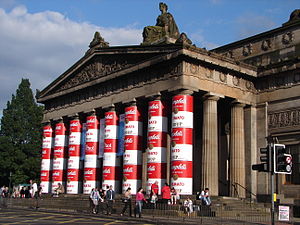Royal Scottish Academy
- For Scotland's national academy, see Royal Society of Edinburgh.


The Royal Scottish Academy (RSA) is a Scottish organisation that promotes contemporary Scottish art. Founded in 1826 as the Scottish Academy, it became the Royal Scottish Academy on being granted a royal charter in 1838. The RSA maintains a unique position in Scotland as an independently funded institution led by eminent artists and architects to promote and support the creation, understanding, and enjoyment of visual arts through exhibitions and related educational events.[1] The RSA is separate from the Royal Academy in London, though there are links between the two organisations.
Overview
In addition to a continuous programme of exhibitions, the RSA also administers scholarships, awards, and residencies for artists who live and work in Scotland. The RSA's historic collection of important artworks and an extensive archive of related material chronicling art and architecture in Scotland over the last 180 years are housed in the Dean Gallery, and are available to researchers by appointment. Displays of the historic collections are mounted whenever possible.
Its home since 1911 has been the Royal Scottish Academy Building on The Mound, Princes Street, Edinburgh, adjacent to the National Gallery of Scotland (NGS). The building is managed by the National Galleries of Scotland but the 1910 Order grants the RSA permanent administration offices in the building. Exhibition space is shared throughout the year with the NGS and other organisations (Exhibiting Societies of Scottish Artists).[2] The building, originally designed by William Henry Playfair, was recently refurbished as part of the Playfair Project, and is also used by the National Galleries of Scotland.
Academicians
The RSA is led by a body of eminent artist and architect members who encompass a broad cross-section of contemporary Scottish art. Members are known as Academicians, and are entitled to use the postnominal letters RSA. The president uses the postnominal letters PRSA while in office, and PPRSA (Past President of the RSA) thereafter.
Academicians are elected to the Academy by their peers. There are also Honorary Academicians (HRSA), including the RSA's patron, the Duke of Edinburgh. After amendments to the Supplementary Charter in 2005, once Associates (ARSA) have submitted a Diploma work into the Permanent Collection of the RSA, they are then entitled to full membership of the Academy. The membership includes 30 Honorary Academicians and 104 Academicians.[3] As of 2010, the RSA President is Professor Bill Scott, Secretary Arthur Watson and Treasurer Professor Ian Howard.[4]
Past Presidents
See also
Notes
- ^ The Royal Scottish Academy of Painting, Sculpture, Architecture and Printmaking
- ^ "ESSA - Exhibiting Societies of Scottish Artists". Retrieved 2009-05-03.
- ^ "Who's Who". Royal Scottish Academy.
- ^ "Full list of RSA Members". Royal Scottish Academy.
- ^ a b "Fine art lecturer elected President of the Royal Scottish Academy". Deadline. Retrieved 12 May 2015.
- ^ "Echo Basin by Ian McKenzie Smith". Art in Healthcare. Retrieved 13 May 2015.
- ^ "The Scotsman". 28 December 2013.
- ^ a b c d e f g h "The Royal Scottish Academy, 1826-1916 : a complete list of the exhibited works by Raeburn and by Academicians, Associates and Hon. Members, giving details of those works in public galleries". Retrieved 12 May 2015.
References
- Esme Gordon (1976) The Royal Scottish Academy of Painting, Sculpture & Architecture 1826-1976. Edinburgh.
External links
- 1826 establishments in Scotland
- Cultural infrastructure completed in 1826
- Category A listed buildings in Edinburgh
- Archives in Scotland
- Arts in Scotland
- Arts organisations based in Scotland
- Scottish architecture
- Scottish artists
- Scottish architects
- Scottish art
- Organisations based in Edinburgh with royal patronage
- Academies of Arts
- Learned societies of Scotland
- New Town, Edinburgh
- Organizations established in 1826
- Scottish contemporary art
